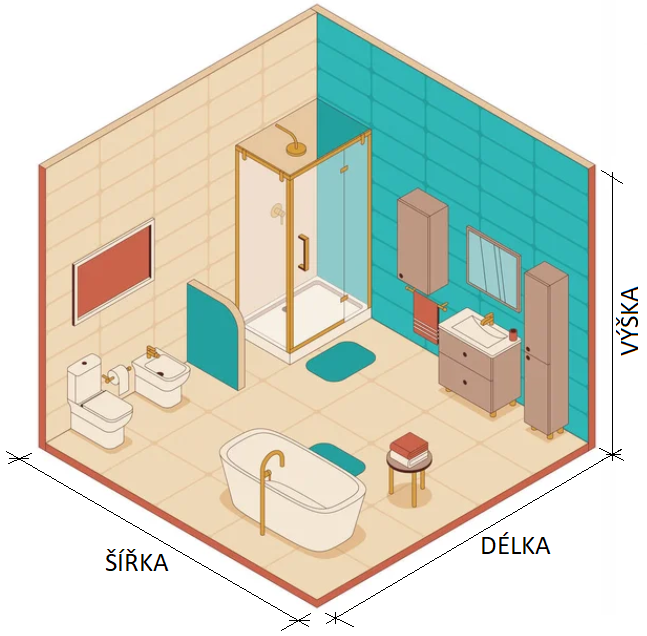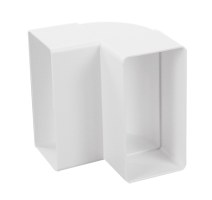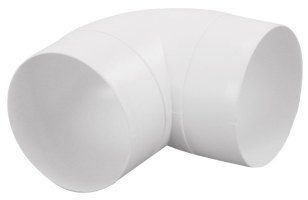Calculation of the Suitable Fan
Selecting the Right Fan for a Bathroom, Basement, or Garage
Choosing the correct fan for your bathroom, basement, or garage is essential to ensure optimal ventilation. If you’re unsure which fan to choose, here’s a simple procedure to help you:
Room Volume Calculation
First, measure the length, width, and height of the space and multiply these values. The resulting volume in cubic meters (m³) will serve as the basis for further calculations.
Determining the Air Exchange Coefficient
Different types of rooms have different air exchange requirements. Each space has its specific coefficient that accounts for factors like humidity and air quality. This coefficient determines how many times per hour the fan should exchange the air in the room. Select the appropriate coefficient from the table below.
Calculating the Required Fan Capacity
Multiply the calculated room volume by the air exchange coefficient. The result will be the minimum fan capacity you will need, expressed in m³/h. This value will help you choose the right fan from the available models.
Example Calculation:
If you have a bathroom measuring 2.4 m (length), 2 m (width), and 2.6 m (height), its volume will be 12.48 m³.
Since bathrooms have higher humidity, an air exchange coefficient of 7 is recommended.
Thus, 12.48 m³ x 7 = 87.36 m³/h.
For this space, you will need a fan with a minimum capacity of 87.36 m³/h.

Recommended Air Exchange Coefficients by Room Type:
| Room Type | Air Exchange Coefficient (k) |
|---|---|
| Bathroom | 6 - 8 (wall/window/ceiling fan) |
| 5 - 7 (fan with timer and hygrometer) | |
| Kitchen | 6 - 10 (wall/window/ceiling fan) |
| 5 - 8 (fan above stove) | |
| Toilet | 8 - 10 (wall/window/ceiling fan) |
| 7 - 9 (fan with timer and hygrometer) | |
| Laundry Room | 10 - 15 (wall/window/ceiling fan) |
| Basements | 4 - 6 (fan in the ventilation duct) |
| Garage | 4 - 8 (wall/window/ceiling fan) |
| Banks | 2 - 4 |
| Offices | 5 - 7 |
| Cinemas - Theaters | 7 - 9 |
| Restaurant Kitchens | 15 - 25 |
| Bars - Cafes | 9 - 11 |
| Laboratories | 5 - 10 |
How to Choose the Right Fan Pressure:
| Duct Length (m) | Fan Pressure (Pa) |
|---|---|
| 2 - 3.5 | 30 - 50 |
| 3.5 - 5.5 | 50 - 65 |
| 5.5 - 8.5 | 65 - 95 |
| 8.5 - 17 | 95 - 140 |
| 17 - 28 | 140 - 250 |
| 28 - 40 | 250 - 380 |
| 40 - 60 | 380 - 600 |
| 60 - 80 | 600 - 850 |
How Duct Fittings Affect Fan Selection:
How Elbows Affect Airflow:
Increased Pressure Loss: An elbow disrupts the laminar airflow and creates turbulence, increasing friction and resistance.
Need for Higher Fan Pressure: The more elbows in the duct, the more the fan needs to work to overcome the increased resistance and ensure the required airflow.
Reduced Airflow Speed: Elbows can slow down the air in the duct, which can lead to inefficient ventilation if not properly compensated by a higher fan capacity.
Calculation of Pressure Loss from Elbows:
Pressure loss from an elbow is typically expressed as the equivalent length of straight duct. This means that the elbow is added to the total duct length based on how many "straight meters" of duct correspond to the resistance it creates.
For example:
A 90° elbow is approximately equivalent to 1-3 meters of straight duct, depending on its radius and duct size.
A 45° elbow creates less loss than a 90° elbow, usually equivalent to 0.5-1.5 meters of duct.
Estimated Pressure Loss from Elbows (Simplified):
You can use the rule of thumb:
A 90° elbow has about 20-30% of the loss caused by the same length of straight duct.
A 45° elbow has about 10-15% of the loss.
For precise calculations, tables of pressure losses or ventilation design software are typically used, taking into account the specifics of the duct, fan, and environment.



Example:
If you have a 10-meter duct with 3 90° elbows, you can approximately add 3-9 meters of straight duct to the total length for the fan capacity calculation.
Recommendation:
Limit the number of elbows in the duct to a minimum to reduce pressure losses and improve ventilation efficiency.
Conclusion:
Elbows significantly affect airflow and pressure losses in the duct. Proper sizing and consideration of these factors when choosing a fan and designing the ventilation system are key to the efficient operation of the system.
Choose the right fan and other accessories, such as ventilation grilles or ducts, at our e-shop: shop.haco.cz.
